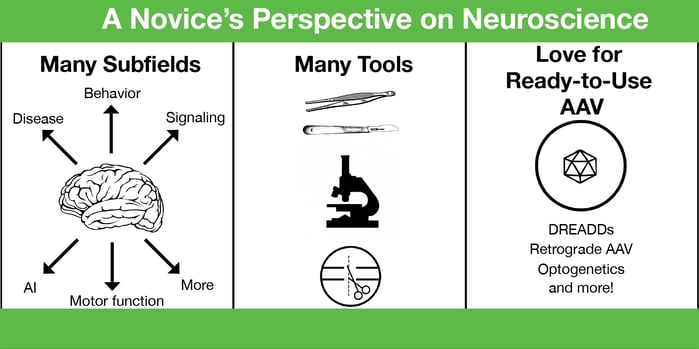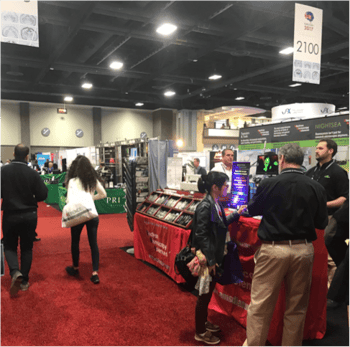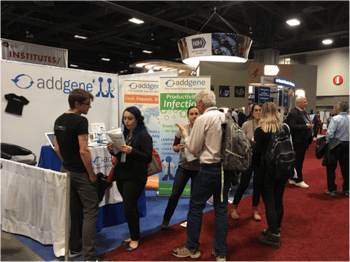
Addgene recently attended the Society for Neuroscience 2017 conference in Washington DC (#SfN17). This massive conference attracted over 30,000 attendees (scientists and nonscientists alike). My only in-depth exposure to neuroscience prior to this conference was a rotation in Qiao Zhou’s lab in graduate school where I worked on a project aiming to dedifferentiate mouse brain cells into neural stem cells. I was quite unsuccesful (although I definitely enjoyed the lab!) and would therefore consider myself a neuroscience novice (newb). In this post, I’d like to highlight some of the things that popped out to me as a novice and indicate why other neuroscience newbies might want to get into the field.
Find Optogenetics Plasmids for Use in Neuroscience Research
Neuroscience covers many subfields
 When I first began looking into the details of SfN17, I expected that almost all of the attendees were going to be molecular biologists. This was not at all the case. The conference featured people who work in sociology, behavior, and artificial intelligence (including a team that created a novel form of AI that can learn new tasks and beat humans at the ancient Chinese game Go). In addition, there was an entire story-telling session organized by Story Collider and which featured a talk about the different parts of the brain stimulated by stories.
When I first began looking into the details of SfN17, I expected that almost all of the attendees were going to be molecular biologists. This was not at all the case. The conference featured people who work in sociology, behavior, and artificial intelligence (including a team that created a novel form of AI that can learn new tasks and beat humans at the ancient Chinese game Go). In addition, there was an entire story-telling session organized by Story Collider and which featured a talk about the different parts of the brain stimulated by stories.
In retrospect, I should have expected this given that the brain controls everything we do, but I was quite impressed by how neuroscientists are using techniques from across different disciplines to better understand neurobiology and human cognition. Developing better AI programs gives neurobiologists new ideas about how the brain functions and vice versa. Even within the biological sciences, there’s plenty of interaction between neuroscience and other fields. For instance I met one researcher studying how the microbiome can affect Alzheimer's - a connection I wouldn’t have thought to make (even if science writer Ed Yong’s book “I Contain Multitudes” has me considering the microbiome more often than not).
If you’re someone who’s considering getting into neuroscience from the mol bio side you’re sure to have many opportunities to learn about and develop technologies that will have impacts on many different facets of life. It also seems as if many of the experiments in neurobiology (and really in all of biology) require large data sets. Whether these data sets include videos of behavior, many many images of brain regions, or sequences of microbial DNA they all seem to require some mathematical know-how for analysis. If you’re looking to get into neuroscience and you don’t have a background in statistics and programming, you’d be wise to start working on these skills.
Neuroscientists use lots of cool tools
While walking around the exhibition area, I got a sampling of the broad variety of tools in neuroscience trade. There were, of course, many companies selling antibodies, microscopes, and dissection tools, but there were also people ready to discuss their VR helmets, gait tracking technologies, and brain monitors.
Walking around the poster presentation area, I honed in on projects using biological tools. In addition to the researcher using sequencing technologies to study microbiome interactions with Alzheimer's, I found others using CRISPR to generate new knockout mice, using adenoviral vectors to deliver IGF receptors to the brain, and probing how fatty acid metabolites affect brain function. These scientists pulled tools from across the biological spectrum to learn more about the brain and neurological disease.
I was surprised at how easily I could jump in and ask questions about the various posters I visited. If you’re interested in neuroscience but are afraid you don’t have the right kind of biological expertise to get into the field, there’s likely some way you can use the tools and skills you’ve developed in your current work to make new insights in neuroscience. Even if you're currently a synthetic biologist engineering E. coli metabolism, maybe you’ll be able to apply your knowledge of metabolism to better understand how aberrations in brain biology lead to altered function or maybe your favorite FRET-based biosensing technique can be applied to an important neuronal signalling pathway - if you’ve got a useful tool, there’s likely someway you can apply it in neuroscience.
AAV tools from Addgene are already having an impact on the field
 Not to toot our own horn too much, but many people who came to the Addgene booth (there were over 400 who signed up for our newsletter and a free plasmid) were very excited about our new viral services. If you’re not familiar, ready-to-use adeno associated virus (AAV) and lentivirus are now available from Addgene. While super useful, these vectors require a bit of expertise and can be difficult for individual labs to make efficiently. For select viral vectors in the repository, you can instead have Addgene make the virus for you.
Not to toot our own horn too much, but many people who came to the Addgene booth (there were over 400 who signed up for our newsletter and a free plasmid) were very excited about our new viral services. If you’re not familiar, ready-to-use adeno associated virus (AAV) and lentivirus are now available from Addgene. While super useful, these vectors require a bit of expertise and can be difficult for individual labs to make efficiently. For select viral vectors in the repository, you can instead have Addgene make the virus for you.
Neuroscientists are particularly interested in using AAVs because they provide a highly versatile means of delivering genes to many different cell types with minimal immunological effects. AAVs are used in experiments targeting genes to specific cell types in the brain, mapping neuronal networks, and selectively activating signaling pathways. Many scientists came to the Addgene booth to learn more about these tools and to tell us how useful the service has been for their experiments. This helped reinforce our goals of making more AAVs and educational content to help researchers use these great tools.
If you’re just getting into neuroscience, you could look to our viral vector pages on the Addgene website and on the Addgene blog to get some ideas for future experiments and to find tools that will make your transition into the field much easier! If there’s a plasmid or AAV tool that you can’t find, you can always suggest a plasmid to us, request that we start making the AAV, or help us produce new educational content on the blog.
Overall, there are many exciting things going on in the world of neuroscience and, like many biological fields the number potential of experiments enabled by physical, software, and biology-based tools as well as collaborations between different fields is quite vast. If you’re a novice neuroscientist looking to get into the field, this is a fantastic time to do it!
Additional Resources on the Addgene Blog
- Advanced Uses of Cre-lox and Flp-FRT - A Neuroscientist's View
- Interview: Ed Boyden on Optogenetics, Neuroscience, and the Future of Neuroengineering
- Primer on Optogenetics
Resources at Addgene.org
- Addgene's Viral Service
- Find Retrograde AAV
- Browse Optogenetics Plasmids
Topics: Viral Vectors, AAV, Neuroscience






Leave a Comment